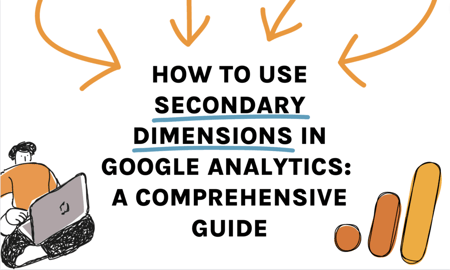Discover Deeper Insights With Additional Dimensions
Second dimensions serve as an effective device in the world of information analysis, using a nuanced viewpoint that goes beyond surface-level monitorings. Keep tuned to discover exactly how secondary measurements can transform the method you analyze and leverage your data for critical advantages.
Advantages of Secondary Measurements

One of the essential benefits of second dimensions is the capability to enhance the context of the key data. This added context makes it possible for experts to draw even more exact conclusions and make educated choices based upon a much more detailed sight of the information. Second dimensions help in offering an extra alternative view of the partnerships in between different variables, thereby assisting in the identification of underlying factors that may influence the main dataset.
Fundamentally, second dimensions play a crucial function in enhancing information evaluation procedures, supplying a more nuanced viewpoint that can bring about actionable recommendations and important understandings.
Implementation Tips for Additional Measurements
Applying secondary dimensions effectively requires a tactical technique that lines up with the certain goals of the information analysis process. To start, it is essential to clearly define the goals of the evaluation and recognize the crucial metrics that will certainly give one of the most beneficial understandings - secondary dimensions. Select secondary dimensions that enhance the key measurements and aid in revealing much deeper patterns or relationships within the data
When executing secondary dimensions, it is vital to consider the context in which the evaluation will certainly be carried out. Understanding the target market and their info needs will certainly lead the selection of relevant second measurements that add meaningful context to the key data factors. Furthermore, ensure that the secondary measurements chosen work with the key dimensions and can be effectively contrasted or incorporated to draw out useful understandings.
Additionally, it is advised to check various mixes of additional and primary dimensions to explore different perspectives and discover hidden partnerships within the data. Routinely reviewing and fine-tuning the option of second dimensions based upon the evolving analytical needs will make sure the evaluation continues to be appropriate and informative.
Studying Data With Additional Measurements

When evaluating data with second dimensions, it is vital to think about how various variables engage with each other. By cross-referencing primary information with secondary measurements, analysts can reveal connections and dependencies that supply a more holistic sight of the data. This strategy not only boosts the accuracy of understandings however additionally assists in making even more informed choices based on the searchings for.
Furthermore, evaluating data with secondary measurements makes it possible for the recognition of outliers or abnormalities that might influence the total evaluation. By diving deeper right into the data via secondary dimensions, analysts can gain a more profound understanding of the underlying factors driving the patterns observed in the primary dataset.
Making The Most Of Insights Through Secondary Dimensions
To extract a higher degree of deepness and precision from information evaluation, leveraging secondary measurements is vital for taking full advantage of understandings. By incorporating secondary dimensions right into your evaluation, you go to my site can discover useful relationships and patterns that may not be right away obvious when taking a look at data via a key dimension alone. Secondary dimensions allow you to cut and dice your information even more, offering an extra thorough understanding of the aspects influencing your metrics.
When utilized properly, additional dimensions can boost the context of your main data, supplying a much more nuanced perspective on your evaluation. For instance, by including additional dimensions such as geography, customer, or time demographics, you can get a deeper understanding of just how different sectors interact with your web content or products.
In addition, secondary measurements can help you determine outliers, fads, and relationships that might or else go undetected. By exploring your information from several angles, you can remove richer insights and make even more informed decisions based upon an extensive understanding of the hidden aspects at play.
When Utilizing Additional Measurements,## Usual Mistakes to Prevent. secondary dimensions.
When integrating second dimensions into data evaluation, it is crucial to be conscious of typical blunders that can impede the removal of valuable insights. One common error is the misuse of additional measurements without a clear purpose in mind. It is important to specify certain objectives and questions prior to picking secondary measurements to ensure they straighten with the evaluation function.
Another error to prevent is overcomplicating the analysis by including also many secondary measurements concurrently. This can cause info overload and make it testing to draw significant final thoughts from the information. It is recommended to start with a few relevant second measurements and slowly integrate much more as needed.
Additionally, ignoring data integrity Website issues can considerably impact the accuracy of insights stemmed from secondary dimensions. Imprecise or insufficient information can misshape the evaluation results and mislead decision-making procedures. Consistently view confirming and cleaning the information is vital to guarantee the reliability of the understandings generated.
Conclusion
Finally, the strategic application of additional dimensions in information analysis supplies an effective device for unlocking much deeper insights and boosting decision-making processes. By including additional layers of details, analysts can acquire a more thorough understanding of their dataset, uncover surprise patterns, and recognize essential variables influencing end results. Via cautious consideration and implementation of additional dimensions, researchers can make best use of the value of their information and drive notified decision-making in various fields.
Select second dimensions that match the key dimensions and assist in revealing deeper patterns or connections within the information.
Additionally, make sure that the second dimensions selected are suitable with the primary dimensions and can be properly contrasted or combined to draw out useful understandings.
Utilizing additional measurements in information analysis enhances the deepness and breadth of insights obtained from the main information factors. By cross-referencing primary data with additional measurements, experts can reveal relationships and dependencies that use a more alternative view of the data. By integrating second measurements right into your evaluation, you can uncover beneficial connections and patterns that might not be right away evident when looking at information via a key measurement alone.